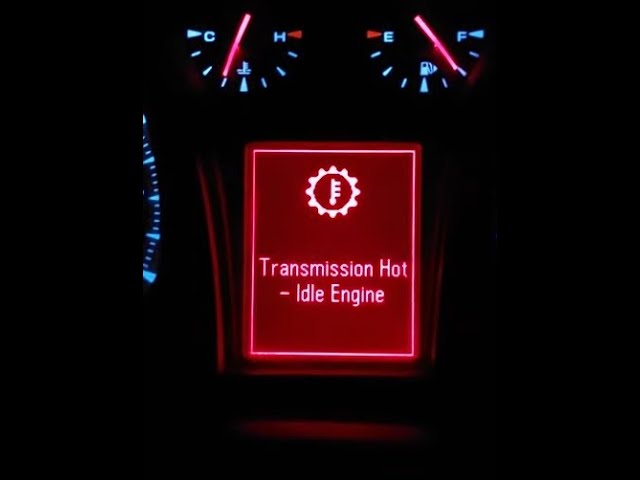A vehicle’s transmission plays a crucial role in powering down the vehicle at various moments. However, the significance of this machinery also brings with it increased risks to the vehicle’s overall functionality.
While there are several factors within your vehicle that may contribute to transmission failure, overheating stands out as the most common culprit. Transmission overheating can result from various factors, emphasizing the importance of identifying the specific cause in your vehicle and addressing it promptly to prevent serious consequences.
To mitigate the issue of the transmission’s hot idle engine, it is advisable to avoid prolonged periods of stop-and-go driving. Additionally, maintaining a clean vehicle and adopting strategies to enhance engine cooling can contribute to resolving this matter.
For your convenience, we have compiled a comprehensive guide highlighting key reasons behind transmission engine overheating during idle periods. Furthermore, we will guide you through potential solutions to address and rectify this problem effectively.
Also Read: Where Is the ESP Sensor Located? Its Importance!
What Does a Car Transmission mean?
Before delving into the primary issue at hand, let’s begin by providing a brief introduction to car transmissions.
As previously noted, the car transmission stands as a pivotal component in a vehicle, facilitating its movement by transferring power from the engine to the wheels.
As you may be aware, car transmissions come in different varieties, with the two primary types being manual and automatic transmissions.
What does Transmission Hot Idle Engine mean?
The term “Transmission Hot Idle Engine” refers to a situation where the transmission of a vehicle becomes excessively heated during periods of idling, such as when the engine is running but the vehicle is stationary.
This condition can lead to various issues and potential damage to the transmission system.
The transmission plays a crucial role in power distribution from the engine to the wheels, and when it becomes excessively hot during idle states, it may indicate an underlying problem.
Several factors can contribute to a transmission becoming hot during idle, including prolonged periods of stop-and-go driving, insufficient cooling, or other issues affecting the transmission’s efficiency.
Understanding the meaning of “Transmission Hot Idle Engine” is essential for vehicle owners to address potential problems promptly and prevent further complications.
Regular maintenance, proper cooling, and identifying and resolving the root cause of transmission overheating are crucial steps in ensuring the optimal performance and longevity of the vehicle’s transmission system.
What causes transmission hot Hot Idle Engine?
-
Insufficient Transmission Fluid
Low transmission fluid levels or degraded fluid can lead to increased friction and heat within the transmission. Regularly check and maintain proper transmission fluid levels to prevent overheating during idle.
-
Faulty Transmission Cooler
A malfunctioning transmission cooler, responsible for regulating the transmission fluid temperature, can contribute to overheating. Damaged or clogged coolers should be inspected and replaced to ensure efficient cooling.
-
Clogged Transmission Filter
A dirty or clogged transmission filter can restrict the flow of transmission fluid, causing increased friction and heat. Regular filter replacements as part of routine maintenance can prevent this issue.
-
Malfunctioning Cooling System
Problems with the overall vehicle cooling system, including the radiator and associated components, can result in inadequate heat dissipation from the transmission. Ensure the cooling system is functioning correctly to prevent transmission overheating.
-
Stressful Driving Conditions
Excessive stop-and-go driving, towing heavy loads, or driving in extreme temperatures can place additional stress on the transmission, leading to overheating during idle. Adjust driving habits and conditions to alleviate strain on the transmission.
-
Clutch Issues (Manual Transmissions)
In vehicles with manual transmissions, a slipping or dragging clutch can generate excess heat. Regular clutch maintenance and timely repairs can prevent overheating during idle.
-
Transmission Fluid Contamination
Contaminants such as dirt or debris in the transmission fluid can impede its ability to properly cool and lubricate the transmission components. Regular fluid changes and using the recommended fluid type can mitigate this issue.
-
Incorrect Transmission Fluid Type
Using the wrong type of transmission fluid can affect its viscosity and heat dissipation properties. Always use the manufacturer-recommended transmission fluid to prevent overheating.
-
Transmission Fluid Leaks
Any leakage in the transmission system can lead to a decrease in fluid levels, resulting in poor lubrication and increased heat. Inspect for and repair any leaks promptly to avoid transmission overheating.
-
Faulty Thermostat
A malfunctioning thermostat in the transmission can disrupt the proper regulation of fluid flow and temperature. Replacing a faulty thermostat is crucial for maintaining the correct operating temperature and preventing overheating during idle.
How to Fix Transmission Hot Idle Engine
Fixing a “Transmission Hot Idle Engine” issue requires identifying the underlying cause and implementing appropriate solutions. Here are general steps to address and resolve the problem:
-
Check Transmission Fluid Levels
Ensure that the transmission fluid levels are within the recommended range. Add fluid if it is low, and use the manufacturer-recommended fluid type.
-
Inspect for Leaks
Look for any signs of transmission fluid leaks. Repair any leaks promptly to maintain proper fluid levels and prevent overheating.
-
Replace or Clean the Transmission Filter
If the transmission filter is dirty or clogged, replace it as part of regular maintenance. A clean filter allows proper fluid flow and cooling.
-
Inspect the Transmission Cooler
Check the transmission cooler for damage or clogs. A faulty cooler can lead to inadequate heat dissipation. Repair or replace the cooler as needed.
-
Verify the Cooling System
Ensure that the overall cooling system, including the radiator and associated components, is functioning correctly. Repair or replace any faulty cooling system parts.
-
Address Stressful Driving Conditions
Adjust driving habits, especially if they involve heavy towing, frequent stop-and-go driving, or driving in extreme conditions. Minimizing stress on the transmission can prevent overheating.
-
Check Clutch (Manual Transmissions)
For vehicles with manual transmissions, inspect the clutch for any signs of slipping or dragging. Replace or repair the clutch components as necessary.
-
Flush and Replace Transmission Fluid
If the transmission fluid is contaminated, consider flushing the system and replacing the fluid. This helps remove impurities and ensures proper lubrication.
-
Use Correct Transmission Fluid
Verify that the correct type of transmission fluid is being used. Using the manufacturer-recommended fluid is crucial for maintaining proper viscosity and heat dissipation.
-
Inspect Thermostat
Check the thermostat in the transmission for proper operation. Replace a faulty thermostat to ensure the correct regulation of fluid flow and temperature.
-
Reduce Idle Time
Avoid prolonged periods of idling, especially in hot conditions. Reduce unnecessary idle time to minimize heat buildup in the transmission.
-
Seek Professional Assistance
If the issue persists or if you are uncertain about the cause, consult with a professional mechanic or transmission specialist for a thorough diagnosis and appropriate repairs.
Where To Find the Transmission In a Car?
The location of the transmission in a car can vary depending on the type of transmission (manual or automatic) and the vehicle’s make and model. Here are general guidelines for both types:
-
Manual Transmission
In vehicles with manual transmissions, the transmission is typically located directly behind the engine. You’ll find a gearbox attached to the engine via the clutch assembly. Manual transmissions are more straightforward, consisting of a gear shifter that the driver manually operates.
-
Automatic Transmission
Automatic transmissions are more complex and often larger than manual transmissions. They are typically located between the engine and the driveshaft. In front-wheel-drive vehicles, the transmission may be transversely mounted, while in rear-wheel-drive or four-wheel-drive vehicles, it is often longitudinally mounted.
-
Under the Hood
Pop the hood of your car, and you may be able to identify the transmission housing. Look for a component that is connected to the engine and has various linkages, cables, and sensors.
-
Transmission Pan
Automatic transmissions have a pan at the bottom that houses the transmission fluid. If you locate the oil pan (which contains the engine oil), the transmission pan is nearby. It is typically flatter and larger than the oil pan.
-
Transmission Tunnel (for Rear-Wheel Drive)
In rear-wheel-drive vehicles, the transmission is often located underneath the vehicle, between the front and rear wheels. There is a raised area on the floor of the car called the transmission tunnel to accommodate the transmission.
-
Transmission Dipstick (for Automatic Transmissions)
Automatic transmissions usually have a dipstick for checking the transmission fluid level. Look for the dipstick handle, which is often color-coded and labeled, near the engine.
How does a Car Transmission work?

A car transmission is a crucial component that plays a key role in the overall operation of a vehicle.
Its primary function is to transmit power generated by the engine to the wheels, enabling the vehicle to move.
The transmission ensures the optimal use of the engine’s power under various driving conditions.
There are two main types of car transmissions: manual and automatic.
Manual Transmission
- Clutch System
In manual transmissions, the system includes a clutch, which is a mechanical device that engages and disengages the engine from the transmission. When the driver presses the clutch pedal, it disengages the engine from the transmission, allowing the driver to shift gears.
- Gear Shifter
The driver uses a gear shifter to manually select different gears. Gears are sets of interlocking toothed wheels that determine the speed and direction of the vehicle. Lower gears provide more torque for acceleration, while higher gears allow for higher speeds.
- Input and Output Shafts
The transmission has an input shaft connected to the engine and an output shaft connected to the wheels. As the driver shifts gears, different sets of gears are engaged, altering the speed and torque delivered to the wheels.
- Clutch Engagement
When the driver releases the clutch pedal, it engages the engine with the transmission, and power is transferred to the wheels based on the selected gear ratio.
Automatic Transmission
Torque Converter
Automatic transmissions use a torque converter instead of a clutch. The torque converter is a fluid coupling that allows the engine to spin independently of the transmission.
Planetary Gearset
Inside the automatic transmission, there is a planetary gearset, a complex arrangement of gears that provides different gear ratios. This eliminates the need for manual gear shifting.
Hydraulic System
The transmission uses a hydraulic system to control the application of clutches and brakes within the planetary gear set. The system relies on transmission fluid to transmit power and control gear changes.
Transmission Control Unit (TCU)
An electronic control unit known as the Transmission Control Unit (TCU) manages the shifting process. The TCU considers various factors such as vehicle speed, engine load, and throttle position to determine the optimal time to shift gears.
Common Principles
- Both manual and automatic transmissions serve the same fundamental purpose: to transmit power from the engine to the wheels.
- The transmission adapts the power output to the vehicle’s speed and load conditions, ensuring efficient and effective operation.
- Regular maintenance, including checking and changing transmission fluid, is essential for the longevity and optimal performance of the transmission.
FAQs – How to Fix Transmission Hot Idle Engine
Why is my transmission overheating at idle?
Transmission overheating at idle can be caused by various factors, including low transmission fluid, a malfunctioning cooling system, a faulty thermostat, or stressful driving conditions such as heavy towing or stop-and-go traffic.
Does idling cool down a transmission?
Idling alone may not be sufficient to cool down a transmission, especially if it is overheating. Engaging in light driving or allowing air to flow over the transmission cooler through movement can contribute to cooling.
How do you cool a transmission?
Cooling a transmission involves:
- Maintaining Proper Fluid Levels: Ensure an adequate amount of clean transmission fluid.
- Efficient Cooling System: Confirm the proper functioning of the overall vehicle cooling system.
- Transmission Cooler: Consider adding an aftermarket transmission cooler for enhanced cooling.
Can a Transmission Get Hot From Idling?
Yes, a transmission can get hot from idling, particularly if the vehicle is stationary for an extended period without sufficient airflow or if there are underlying issues causing overheating.
What Are Some Signs of Low Transmission Fluid?
Signs of low transmission fluid include slipping gears, delayed or rough shifting, unusual noises, and transmission overheating. Check fluid levels regularly and address any leaks promptly.
Can Transmission Run to Cool?
Yes, light driving can help cool a transmission as it allows air to flow over the transmission cooler, aiding in the dissipation of heat.
Does Low Coolant Mean Transmission Overheating?
Low coolant levels can contribute to overall overheating issues in a vehicle, but it does not directly cause transmission overheating. However, maintaining proper coolant levels is crucial for the overall health of the engine and, indirectly, the transmission.
Is It Safe To Drive With a Hot Transmission?
Continued driving with a hot transmission is not recommended, as it can lead to severe damage. It’s advisable to address the overheating issue promptly to prevent long-term damage and costly repairs.
Conclusion – How to Fix Transmission Hot Idle Engine
To sum it up, keeping your car’s transmission in top shape is crucial for a smooth ride and a long-lasting vehicle.
If you notice signs of overheating, like rough shifts or strange noises, don’t ignore them.
Regularly check your transmission fluid, fix leaks pronto, and stick to your vehicle’s maintenance schedule.
Knowing how your transmission works empowers you to make smart choices on the road.
So, next time you’re idling or facing stop-and-go traffic, remember the impact it can have on your transmission.
By following these simple tips, you’re not just caring for your car; you’re ensuring countless miles of trouble-free driving.
Stay savvy, drive safe!




